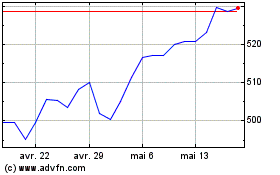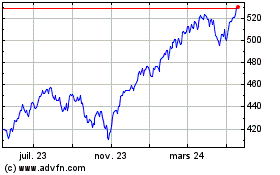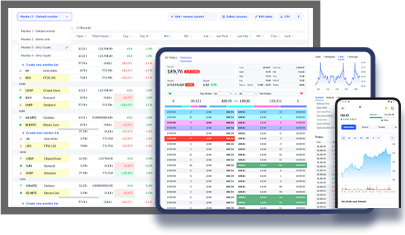Uber Stock Spikes On Its Inclusion in the S&P 500 Index
04 Décembre 2023 - 10:59AM
Finscreener.org
Uber (NYSE:UBER)
shares saw a 5% increase in extended trading on Friday following
the announcement that it will be joining the
S&P 500 Index,
taking the place of Sealed Air Corp
(NYSE:SEE). As stated in a recent press release, this
adjustment is scheduled to occur before trading opens on Monday,
December 18.
When a company is included in the
S&P 500, its stock price typically experiences a boost. This
is because portfolio managers who align with the index, updated
quarterly, are required to purchase its stocks. To be eligible for
inclusion, companies must meet specific criteria regarding their
valuation and profitability.
Uber boosts profitability in recent months
Since its debut on the New York
Stock Exchange in 2019, Uber has grappled with high operational
costs, particularly in its competitive ride-hailing segment.
Initially, the company focused on adjusted EBITDA (earnings before
interest, tax, depreciation, and amortization) as its key financial
metric.
A significant portion of Uber’s
adjusted EBITDA has been derived from its mobility services.
However, the company expedited the profitability of its delivery
segment, driven by the recession-wary investment climateU+02019s
reluctance toward funding loss-making enterprises.
Additionally, increasing
advertising revenue has also bolstered UberU+02019s financial
health.
In response to these challenges,
Uber undertook significant cost-cutting measures in 2020, including
eliminating over 3,500 jobs.
Subsequent efforts by its
executives have focused on refining the company’s cost structure,
such as optimizing delivery expenses. In its third quarter, Uber
reported a net income of $221 million, with revenues totaling $9.29
billion. Over the past four quarters, the company has accrued a
profit exceeding $1 billion.
Uber CEO Dara Khosrowshahi, in a
discussion with UBS analyst Lloyd Walmsley at a December 2021
investor meeting, emphasized the goal to develop Uber into a
company capable of sustaining impressive top-line growth and
progressively enhancing margins over time.
As per the S&P 500U+02019s
inclusion criteria, companies must demonstrate positive earnings in
the most recent quarter and cumulatively over the past four
quarters. Additionally, a minimum adjusted market capitalization of
$14.5 billion is required. Uber boasts a market capitalization of
approximately $118 billion, significantly higher than the
S&P 500U+02019s median company market cap of just over $31
billion.
Is Uber stock a good buy right now?
Uber, renowned for its
ride-sharing services, also runs the
popular food delivery platform Uber Eats and a commercial freight
service named Uber Freight.
In its latest third-quarter
report, ending September 30, Uber witnessed a 25% year-over-year
increase in its operations, completing 2.4 billion trips through
ride-hailing and food delivery services. The company reported a
substantial $35.2 billion in customer bookings across its varied
services, encompassing rides, food, and freight
deliveries.
However, Uber faces substantial
operational costs. The company earns a fraction of each trip its
drivers complete, converting $35.2 billion in bookings to $9.2
billion in revenue. After accounting for operational expenses, the
net income stood at a modest $221 million for the
quarter.
A significant portion of
UberU+02019s expenses is attributed to its vast network of 6.5
million drivers, to whom it paid $16 billion in the third quarter
alone, nearly half of its total bookings. Significantly reducing
this cost could drastically alter UberU+02019s financial dynamics,
allowing the company to retain a larger share of revenue from each
service booked by customers.
Can Uber be valued at $1 trillion?
Uber is projected to achieve a
revenue of $35.4 billion for the entire year of 2023. Given its
current market cap, UBER stock trades at a price-to-sales (P/S)
ratio of approximately 3.3.
The ratio is significantly lower
than its peak P/S ratio of 8.9. However, taking a midpoint between
these two figures, a long-term P/S ratio of around 5.8 seems
feasible.
To reach a market valuation of $1
trillion by 2033, Uber would need to ramp up its annual revenue to
an impressive $173 billion. This ambitious goal requires the
company to sustain an average annual revenue growth of 17.2% over
the next decade.
SPDR S&P 500 (AMEX:SPY)
Graphique Historique de l'Action
De Oct 2024 à Nov 2024

SPDR S&P 500 (AMEX:SPY)
Graphique Historique de l'Action
De Nov 2023 à Nov 2024



